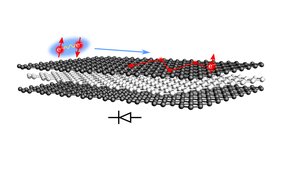One speaks of a superconducting diode effect when there is a magnitude of the current for which a material behaves like a superconductor in one direction of current flow and like a resistor in the other. In contrast to a conventional diode, such a superconducting diode exhibits a completely vanishing resistance and thus no losses in the forward direction. This could form the basis for future lossless quantum electronics. Physicists succeeded in creating the diode effect about two years ago, but with some fundamental limitations. The new experiments carried out in the group of Jia Li at the renowned U.S. Brown University, described in the current issue of Nature Physics, feature an extremely strong diode effect: when turning on an electrical current in one direction, the system almost immediately becomes a resistor while it stays superconducting for currents in the opposite direction. Moreover, the diode direction can be reversed by a simple electric field. “This alone makes trilayer graphene such a promising platform for the superconducting diode effect," clarifies Mathias Scheurer from the Institute of Theoretical Physics at the University of Innsbruck, who received an ERC Starting Grant this year for his research on two-dimensional materials, especially graphene. In addition, the system realizes the unique situation of a diode effect at zero external magnetic field in a single, homogeneous superconductor. This confirms a hypothesis previously theorized by Mathias Scheurer: Namely, that superconductivity and magnetism coexist in a system consisting of three graphene layers twisted against each other. The system thus virtually generates its own internal magnetic field, creating a diode effect.
Promising material graphene
The diode effect described in Nature Physics was produced with graphene, a material consisting of a single layer of carbon atoms arranged in a honeycomb pattern. Stacking several layers of graphene leads to completely new properties, including the ability of three graphene layers twisted against each other to conduct electric current without loss. The fact that a superconducting diode effect exists without an external magnetic field in this system has great implications for the study of the complex physical behavior of twisted trilayer graphene, as it demonstrates the coexistence of superconductivity and magnetism. This shows that the diode effect not only has technological relevance, but also has the potential to improve our understanding of fundamental processes in many-body physics. The theoretical basis for this has already been published in another high-ranking publication.
Publikation: Zero-field superconducting diode effect in small-twist-angle trilayer graphene.
Jiang-Xiazi Lin, Phum Siriviboon, Harley D. Scammell, Song Liu, Daniel Rhodes, K. Watanabe, T. Taniguchi, James Hone, Mathias S. Scheurer, J.I.A. Li in: Nature Physics, August 2022. DOI: 10.1038/s41567-022-01700-1

